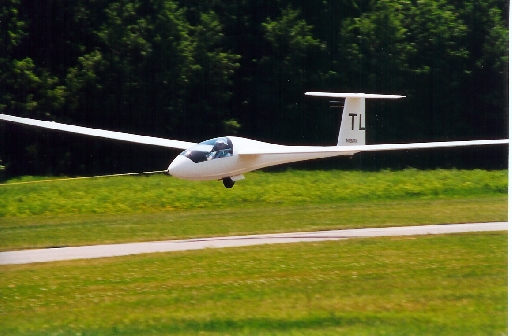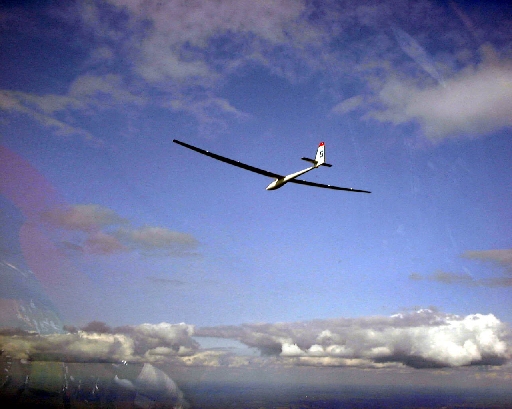Twenty years from now how will I answer my son when he asks "Dad what
did you do when I wasn't there?" How can I express to him the harmony
of a trip to the top of the sky? I hope someday he must explain to
his son as rewarding an addiction as mine.

Last Sunday we opened Sugarbush in force a week early. The forecast
was for rain but my personal logistics required me to move YG to
Vermont a week befor opening day. Tony "TL" Lauck, Bob "90" Fletcher,
Robert "8U" Messner and others showed as well. My excuse was that I
had to drop off the glider so I could pick up my son Brett by air on
opening weekend. I don't know theirs.
Sunday dawned with lots of wind and a much better than forecast look
to it, wave for certain. Us die hards hit the field early. The
airport wind sock stood straight out pointing north. The Gazebo sock
did the same but, pointing south.
While we assembled gliders we saw Mindy "you call we haul" Woodruff
take a couple of hops in the towplane. Soon he came back and allowed
as to how it was pretty rough and it might be a good idea to wait for
an hour or so. He then took off for hanger chores. Bob Fletcher's
comment: "Boy if Mindy thinks its rough I really WANT to wait."
The hour was well spent, the wind died down enough to be safe and I
got jostled into being the first off. No problem, just an ordinary
rotor tow to the parking lot. I only hit my head twice. Off tow a
touch lower than I should I promptly lost the wave. Fighting to say
aloft in rotor thermals I worked my way from the parking lot out the
northern spur to the route 100 valley. After about 20 minutes of
tough work I got high enough in the rotor to contact the wave. For
those who havent tried it, rotor means simply that the thermals run
around faster than you can. You spend all your time chasing them and
keep bumping into them but never quite catch one.

Wave lift is fun. Its smooth and still. You sit going up faster than
an express elevator and feeling absolutely motionless. On this flight
I passed through 14,000 feet and got my oxygen on. Then I called
Boston Center (on 134.7) and told them I was heading for more than
18,000. When I got to 16,000 they opened the Sugarbush wave window
to 19,000. I got clearance for more altitude whenever I needed it.
I talked to Doug "DJ" Jacobs who was doing some serious cross country
from Sterling. Good lift down there. I could hear Tim Wells at Elmira
but got no answers to my radio calls.
At 20,000 feet and -14 degrees F my wings started to buzz. I
contemplated the issues of how to make a jump from my altitude
without freezing to death on the way down. Terminal velocity about
100 miles an hour almost three miles up thats about a minute and a
half to fall before opening, a long slow count to 180. When I got
that far would I still be warm enough and alert enough to pull the
ripcord? Or is it better to just give it a 20 count and then freeze
on the way down for close to 10 minutes, hoping medical science can
cure whatever frostbite occurs?
Well the smart thing to do with something you don't understand is
nothing. Just fly the plane carefully and try to puzzle it out.
Slower speeds stopped the buzzing, faster made it worse. The glider
felt funny, but it flew OK. It was some 10 minutes later when I could
finally see what was going on. Tape sealing between the flaps and
the wing had lifted up. It finally came up enough for me to see it
vibrate in the wind. I watched as a piece tore back and flew off.
The buzzing got better. Just a flap seal that couldn't take the
cold. For the next 15 minutes I just wished that the rest of it would
hurry up and fall off to restore the normal quiet. I lost all 15
meters of sealing tape by the end of the flight.

To get high in wave lift you must play with it. Playing with the
wave is moving from one place to another looking for better lift. I
played, enjoying the perspective. The wind holds you still against
the ground. Moving in the wave is done by speeding up to move forward
(upwind) or slowing down to move back. Turning at an angle and
speeding up moves you along the axis of the wave (crosswind). Your
motions are slow, 5 mph is a lot. Usually the best lift is above the
Sugarbush parking lot. Sunday it was further north, halfway between
Mad River ski area and Camel's hump.
As I ascended the world expanded beneath me. Mountains got small and
became almost invisible below a blanket of white. The edges of my
world extended downward like an upside down plate. The air was
smooth and quiet. Time passed unnoticed. The very bigness of the sky,
like the "big sky country" of the western plains filled me with the
special peace of the wave.
Patience is also important to getting high. Below 20 thousand feet I
had gone up fast. Now at the fringe of the lift up was feet per
minute, and small numbers of feet at that. I moved left and right
foreward and back seeking that little extra lift that would give me a
few extra feet. From 20 thousand feet to 23,000 feet took more than
an hour. I played some more but the top was 23,000 feet, no more.
I should also tell about going to Morrisville and Killington on the
way down. From the exalted height of 4 miles up my gliding range is a
whopping 160 miles, much further than my cold feet would allow.
Besides Morrisville is north along the wave and Killington is south
along the wave. At 120 knots I was hard pressed to lose altitude
along the way. The whole trip took less than an hour.
Wave flying is a new and, in spite of its peace and beauty, somewhat
dangerous animal. Last Sunday there were two dangers to watch. First
the possibility of the window closing and trapping you above a solid
deck of cloud. This would not be a big problem on this day. Second
the landing. With a crosswind of 30 knots and a Baron parked midfield
landing proved to be the big problem of the day. Airspeed on final
was 80 knots a number which sounds high but was just right this day.
Gusts caused me to bounce twice and I turned out into the grass for
clearance behind the Baron and a heading more into wind. I was
thankfull that this difficult chore was completed.
Of course I landed half an hour too soon. After I was the guinea pig
the others waited untill I got the glider off and out of the way.
They listened to my advice and found that when the wind died down a
bit things were much easier. I've made worse landings, I think...
Story Copyright (c) 1992 by Michael Newman
|



